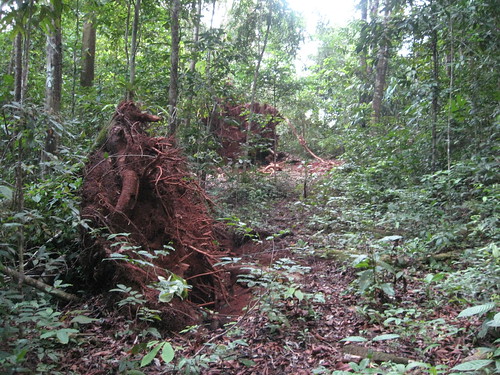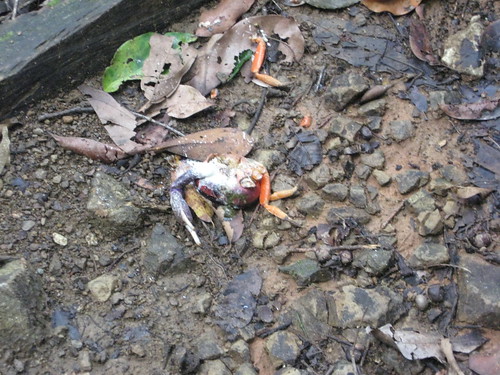 This post is going to pick up where the previous Costa Rica post left off because it is important to understand. When most people think of rain forests like the ones that exist in Costa Rica they think of plentiful large plant life and lots of exotic animals. This often leads to the association of plants in more temperate areas that have extensive amounts of soil under them. Well what you should notice based on the picture to the left [photo of a root ball on a tree in Costa Rica by author, I could not find a more temperate forest root ball to compare it to so if you know of one feel free to post the link below] is that this is not true. The actual soil in most rain forests is typically very thin but why is this and what does this have to do with conservation?
This post is going to pick up where the previous Costa Rica post left off because it is important to understand. When most people think of rain forests like the ones that exist in Costa Rica they think of plentiful large plant life and lots of exotic animals. This often leads to the association of plants in more temperate areas that have extensive amounts of soil under them. Well what you should notice based on the picture to the left [photo of a root ball on a tree in Costa Rica by author, I could not find a more temperate forest root ball to compare it to so if you know of one feel free to post the link below] is that this is not true. The actual soil in most rain forests is typically very thin but why is this and what does this have to do with conservation?Well the reason for this is due directly to the large amount of plants and animals along with the large amount of rain that occur in rain forests. When a dead organisms falls to the ground in a more temperate forest decay begins immediately but is slowed by a lower amount of rain and as one goes further north colder winter temperatures. In the rain forest you have warm humid climatic conditions year round, these are ideal conditions for decomposers so decomposition takes place very quickly. This means in order for plants and animals to get nutrients from decomposing organisms they must be able to do so quickly so this leads to a huge competition for these nutrients and with so many organisms competing for these nutrients the soil very quickly depletes the soil.
 Rain also effects the soil in any given environment. If a farmer clears land then it proceeds to rain the rain will wash away some of the soil. The same thing occurs in nature in forests as well. In a temperate forest the rain may wash away some of the soil but typically plants grow up in the thicker soil before the rain has a chance to wash it away and the plants help lock down the soil. In rain forests we have a perfect storm we have already thin soil and we have plentiful pretty much daily rain so before plants have a chance to start growing a lot of the soil is lost [photo at right of a dead crab, you can ignore this for this post on very depleted soil by author]. This leads to areas where the soil remains exposed we end up with typically iron and felsic rich soils. These soils do not have the nutrients that are needed to support plant life and do to the large amount of rain it is hard to get plants to regrow in these areas. So what does this mean?
Rain also effects the soil in any given environment. If a farmer clears land then it proceeds to rain the rain will wash away some of the soil. The same thing occurs in nature in forests as well. In a temperate forest the rain may wash away some of the soil but typically plants grow up in the thicker soil before the rain has a chance to wash it away and the plants help lock down the soil. In rain forests we have a perfect storm we have already thin soil and we have plentiful pretty much daily rain so before plants have a chance to start growing a lot of the soil is lost [photo at right of a dead crab, you can ignore this for this post on very depleted soil by author]. This leads to areas where the soil remains exposed we end up with typically iron and felsic rich soils. These soils do not have the nutrients that are needed to support plant life and do to the large amount of rain it is hard to get plants to regrow in these areas. So what does this mean?This basically means that if we cut and burn and start trying to farm is these types of environments we lose most of the soil very quickly so we need more land. The land that had been farm land does not grow any plants anymore and continues to become more and more enriched in iron etc and gets more and more depleted in nutrients. This land eventually becomes almost rock like and will not grow plants so the farmers need more land so they slash and burn more land in the forest to be able to grow more crops, this is a big problem in places like Brazil.
Humans need food, however, so we need to do something. Well there are a couple ways to address this the first is that these countries could import food from countries that do not have similar problems. This is expensive, however, and leaves that country open to manipulation by foreign countries in exchange for food and as such is not preferable. The other main option is a crop rotation pattern. You could allow native plants to grow for a little while develop a more native soil pattern then cut it back and farm it for a couple of years then allow the forest to come back. This idea in and of itself isn't perfect and in the long run could prevent a country from growing enough food to support itself.
So which is best? I can't say and in fact their could be other options that I did not list here, feel free to put some in the comments section. It is important to note that in many parts of Costa Rica the locals have, however, taken advantage of the more natural way of growing food in many areas and if you stay try to stay at a ecolodge. These ecolodges typically produce their power and get food from sustainable sources which is good for Costa Rica and the world in general. The next post will also partially deal with conservation but in a slightly different way, as always I more than welcome your questions or comments below.

No comments:
Post a Comment